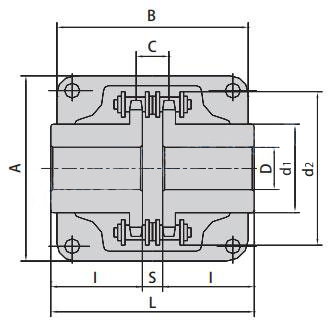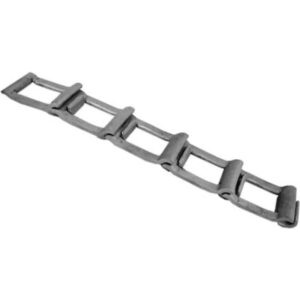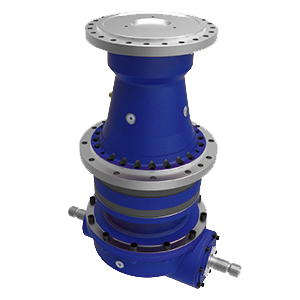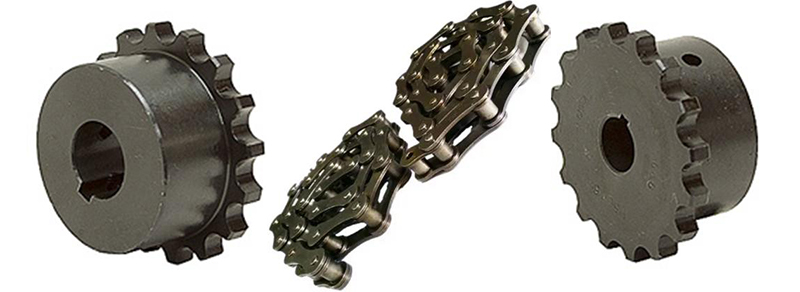Chain Couplings
Chain couplings are mechanical devices for connecting two shafts. They consist of two rows of roller chains with sprockets that engage them. The shafts are then cranked to move the coupling. Chain couplings are available in a range of sizes and torque capacities.
Chain Couplings
The chain coupling is composed of a duplex roller chain and a pair of coupling sprockets. The function of connection and detachment is done by the joint of the chain. It has the characteristic of being compact and powerful, excellent durability, safe and smart, simple installation and easy alignment. The chain coupling is suitable for a wide range of coupling applications.
 |
 |
Parameters of Chain Couplings
| Chain Coupling No. | Chain No. | Bore Dia | Dimension | Inertia | Approx Weight | Casing | ||||||||
| Min | Max | L | I | S | d1 | d2 | C | ×10-3 | Dimension | Approx Weight | ||||
| A | B | |||||||||||||
| mm | mm | mm | mm | mm | mm | mm | mm | kgf·m2 | kg | mm | mm | kg | ||
| 3012 | 06B-2X12 | 12 | 16 | 64.8 | 29.8 | 5.2 | 25 | 45 | 10.2 | 0.233 | 0.4 | 69 | 63 | 0.3 |
| 4012 | 40-2X12 | 12 | 22 | 79.4 | 36.0 | 7.4 | 35 | 61 | 14.4 | 1.020 | 0.8 | 77 | 72 | 0.3 |
| 4014 | 40-2X14 | 12 | 28 | 79.4 | 36.0 | 7.4 | 43 | 69 | 14.4 | 1.924 | 1.1 | 84 | 75 | 0.4 |
| 4016 | 40-2X16 | 14 | 32 | 87.4 | 40.0 | 7.4 | 50 | 77 | 14.4 | 3.285 | 1.4 | 92 | 75 | 0.4 |
| 5014 | 50-2X14 | 16 | 35 | 99.7 | 45.0 | 9.7 | 53 | 86 | 18.1 | 6.010 | 2.2 | 101 | 85 | 0.5 |
| 5016 | 50-2X16 | 16 | 40 | 99.7 | 45.0 | 9.7 | 60 | 96 | 18.1 | 9.720 | 2.7 | 111 | 85 | 0.6 |
| 5018 | 50-2X18 | 16 | 45 | 99.7 | 45.0 | 9.7 | 70 | 106 | 18.1 | 15.420 | 3.8 | 122 | 85 | 0.8 |
| 6018 | 60-2X18 | 20 | 56 | 123.5 | 56.0 | 11.5 | 85 | 128 | 22.8 | 40.210 | 6.2 | 142 | 106 | 1.2 |
| 6020 | 60-2X20 | 20 | 60 | 123.5 | 56.0 | 11.5 | 98 | 140 | 22.8 | 62.870 | 7.8 | 158 | 105 | 1.6 |
| 6022 | 60-2X22 | 20 | 71 | 123.5 | 56.0 | 11.5 | 110 | 152 | 22.8 | 93.450 | 10.4 | 168 | 117 | 1.8 |
| 8018 | 80-2X18 | 20 | 80 | 141.2 | 63.0 | 15.2 | 110 | 170 | 29.3 | 142.030 | 12.7 | 190 | 129 | 2.5 |
| 8020 | 80-2X20 | 20 | 90 | 145.2 | 65.0 | 15.2 | 120 | 186 | 29.3 | 204.900 | 16.0 | 210 | 137 | 2.9 |
| 8022 | 80-2X22 | 20 | 100 | 157.2 | 71.0 | 15.2 | 140 | 202 | 29.3 | 341.170 | 20.2 | 226 | 137 | 3.6 |
| 10020 | 100-2X20 | 25 | 110 | 178.8 | 80.0 | 18.8 | 160 | 233 | 35.8 | 646.290 | 33.0 | 281 | 153 | 4.6 |
| 12018 | 120-2X18 | 35 | 125 | 202.7 | 90.0 | 22.7 | 170 | 256 | 45.4 | 1075.710 | 47.0 | 307 | 181 | 6.2 |
| 12022 | 120-2X22 | 35 | 140 | 222.7 | 100.0 | 22.7 | 210 | 304 | 45.4 | 2454.500 | 72.0 | 357 | 181 | 8.0 |
What Are Chain Couplings?
Chain couplings are mechanical devices for connecting two shafts. They consist of two rows of roller chains with sprockets that engage them. The shafts are then cranked to move the coupling. Chain couplings are available in a range of sizes and torque capacities.
Chain couplings are all steel and compact for space-constrained applications. They transmit high torques and offer positive power transmission. Unlike conventional couplings, chain couplings require less space and are easily installed and dismantled. They also provide a balanced unit operation, which is essential for high torques. Chain couplings are typically used in low-speed, high torque applications. They also offer a high degree of flexibility and allow for misalignment of up to 2 degrees between the shafts.
Advantages of a Chain Coupling
A chain coupling is a type of transmission system that uses a single common chain, meshing with two parallel sprockets to transfer power from one shaft to the other. A chain coupling comes in various varieties, including roller chain coupling, toothed chain coupling, and nylon chain coupling. The benefits of a chain coupling include its simplicity, reliability, and low installation accuracy. A chain coupling is a common option for shafting transmission applications, especially in low-speed, high-torque applications.
One of the most important advantages of chain couplings is their high-torque capability. Because they are made of two flanges linked by a duplex roller chain, they are ideal for high-torque applications. They can accommodate up to 2 degrees of misalignment, which makes them a common choice for applications that require high torque. Another advantage of chain couplings is their ease of installation and low-maintenance requirements.
Besides being easy to assemble, a chain coupling also keeps the two shafts perfectly aligned. It also minimizes shock and vibrations during power transmission. It should also have a low-profile design and be easy to fit between two shafts. And, of course, it should be able to transmit power from one shaft to the other. These features are essential for high-speed applications.
We’re one of the professional coupling manufacturers that you can rely on, can offer high-durability China chain couplings at reasonable prices! Feel free to contact us!
Applications of Chain Couplings
Chain couplings are usually employed in low to moderate-speed, high-torque applications and are not often found in higher-speed applications where grid, gear, and other more sophisticated couplings predominate. They are considered to be fairly rugged and easy to install. Typical applications include line-shaft couplings on live-roller conveyors. Here, the plastic chain provides a lubrication-free coupling solution that requires neither covers for lubricant retention nor coupling guards because the smooth outer surface of the chain presents no catch hazards.
For standard power transmission applications, chain couplings can be purchased in a range of shaft sizes and torque capacities, with typical bore diameters up to 4-1/2 in. and torque capacities up to 220,000 in.-lbs. available. Allowable angular misalignment is usually a maximum of 1° and parallel misalignment is usually limited to 2% of the chain pitch. Sometimes these allowances are decreased for installations that operate at higher speeds.
Sprockets are sized in two-tooth intervals to correspond to the roller chain links, with pitches based on ANSI standards (i.e., #40, #60, #80). Ordinarily, the manufacturer will select the appropriate sprocket size and pitch for the given torque requirements, but knowing the pitch of the sprocket makes it possible to select an appropriate replacement chain.
How to Install a Roller Chain Coupling?
Our chain couplings feature a unique single-pin design that greatly simplifies the installation process. Simply follow these simple steps.
- Install the oil seal on each hub
- Adjust the alignment of the shaft and coupling assembly
- Adjust the distance between the sprocket faces
- Thoroughly lubricate the coupling chain
- Install the chain to the coupling using the single pin coupling ring
- Firmly close and secure the coupling cover (optional, depending on operating conditions)
The chain coupling installation process is simpler and faster than conventional rigid couplings.

Packing Shipping Delivery
  |
 |
|
 |
 |
|
How to choose power transmissions parts and industrial products which meet our requirement
| Chains | Sprockets | Pulleys | Timing belt Pulley | V-belt Pulley |
| Sheaves | Coupings | Bush &Hub | Gear& Rack | V-Belt |
| Locking Assembly | Pulley | Gearbox | Reducer | Shaft Collar |
| Rod End Bearing | Clevis | PTO | Chain Guide | Belt Guide |
| Rubber Buffer | Chain Tensioner | PTO Drive Shafts | Universal Joints | Roller Chains |
| Conveyor Chains | V-Belts | Worm Gearbox | Helical Gear | Worm |
| Agricultural Chain | CNC Proces Parts | Casting | Stamping | |
| Powder Metallurgy | CNC Proces Parts | Casting | Stamping |
What Products Do you sell ?
We are a group of factories, give customer one stop solution of power transmission and industrial products. We are in the position to supply wide range of products, including chains, sprockets, v-belt and v-belt pulleys, timing belt and timing belt pulleys, gears, speed reducers, motors, racks, couplings, and many other parts, like locking assembly, taper bushing, Chain guide, shaft collar, torque limiter, cam clutch, universal joint, motor base and motor slide, rod end, clevis, rubber mount, etc. We make special parts according to drawings and/or samples.
How to choose a gearbox which meets our requirement?
You can refer to our catalogue to choose the gearbox or we can help to choose when you provide
the technical information of required output torque, output speed and motor parameter etc.
What information shall we give before placing a purchase order?
a) Type of the gearbox, ratio, input and output type, input flange, mounting position, and motor informationetc.
b) Housing color.
c) Purchase quantity.
d) Other special requirements.
What industries are your gearboxes being used?
Our gearboxes are widely used in the areas of textile, food processing, beverage, chemical industry,
escalator,automatic storage equipment, metallurgy, tabacco, environmental protection, logistics and etc.
What is the producing process?
Production process including raw material cutting, machine processing, grinding, accessories cleaning, assemble, cleaning, stoving, oil coating, cover pressing, testing, package.
How to control the products quality?
Combining advanced equipment and strict management, we provide high standard and quality bearings for our customers all over the world.
What is the transportation?
-If small quantity , we Suggest to send by express, such as DHL,UPS, TNT FEDEX. If large amount, by air or sea shipping.
Can we design packaging?
-Yes. Default is regular packing, and we can make customer's own packing.
Can you provide OEM service?
-Yes, we work on OEM orders. Which means size, quantity, design, packing solution, etc will depend on your requests; and your logo will be customized on our products.
Can you give me discount on Power Transmissions Parts and Industrial parts?
-Yes, of course. Pls. send me your Email, you'll get more
Q: Are You a trading company or a manufacturer?
A: We Are the factory and have our Own trading company
Q: How Can I get an offer?
A: please send US quotation information: drawings, materials, weight, quantity and requirements, we can accept PDF, ISGS, DWG, STEP file format. If you don't have the drawings, please send us the samples, we can also quote you according to your samples.
Q: What is your minimum order size?
A: it is usually 100 pieces, but a low quantity is acceptable under some special circumstances.
Q: Do you provide samples? Is it free or extra?
A: Yes, we can provide samples free of charge, but we don't pay the freight.
Q: What is the lead time for mass production?
A: honestly, it depends on the number of orders. Normally, if you don't need the tools, deposit them after 30 days or so.
Q: What if the parts don't Work?
A: we can guarantee the quality, but if it happens, please contact us immediately, take some photos, we will check the problem and solve it as soon as possible.
Q: What are your terms of payment?
A: payment is less than US $1000,100% in advance. Payment: $1000,50% wire transfer in advance, balance before shipment,Other Terms of payment are negotiable





Reviews
There are no reviews yet.